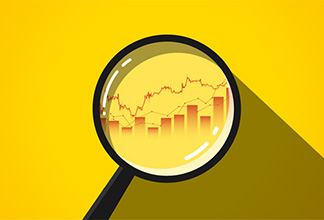A Bank With A Mission: How Central Banks Shape the Economy and Your Money Decisions
Written by Owen Guo and Nicholas Mizera | Published on February 24, 2023
Written by Owen Guo and Nicholas Mizera | Published on February 24, 2023
Central banks wield enormous power. They are not your everyday banks. You can't pop in to stash your cash. There are no branded ATMs. No welcoming reception areas for customers.
Think of central banks as something of a spigot, tasked to maintain the right amount of money supply – not too much, not too little – to keep the economy humming. You've likely heard a lot about central banks in the news lately – for good reason. Their decisions can affect your relationship with money, from mortgage costs to interest on your savings account and your stock performances.
Here's a primer on central banks' inner workings and how they affect your finances.
Central banks are best known for setting interest rates, which affect the broader economy and your investing strategies. As recently as early 2020, most Western central banks kept rates close to zero, which was meant to make borrowing easy.
Then supply-chain snarls and a host of other pandemic shocks led to eye-popping inflation in many advanced economies, including here in Canada.
In response, the Bank of Canada (BoC) lifted interest rates seven times in 2022. Then it kicked off 2023 with another modest bump, pushing the benchmark rate to 4.5 per cent. The aggressive rate hikes, economists say, are aimed at cooling inflation by slowing demand.
For consumers, the rate hikes have wide implications. Debt payments for Canadian households, for example, are projected to jump to a record 16 per cent of disposable income by the end of 2023, according to RBC Economics. That said, higher rates can give a boost to fixed-income investments such as guaranteed investment certificates (GICs).
Amid signs of easing inflation, the BoC has signaled that it's likely to halt rate hikes, contingent on future inflation readings. “We have raised rates rapidly, and now it's time to pause and assess whether monetary policy is sufficiently restrictive to bring inflation back to the two per cent target," Bank of Canada Governor Tim Macklem told reporters in January.
Macklem's remarks highlight an important task of central banks: controlling inflation.
Some central banks have a dual mandate, like the U.S. Federal Reserve, which means they have twin goals of maintaining healthy levels of employment and a target inflation rate. The Bank of Canada, on the other hand, exclusively targets inflation, which it aims to keep at the 2 per cent midpoint of a target range of one to three per cent.
When inflation is high, central banks will try to curtail consumer spending by raising interest rates – and therefore borrowing costs. Central bank officials monitor labour market conditions, too. This is because a robust labour market can sustain price pressures as wages increase and companies charge more.
With interest rate decisions, central banks are hoping for a “soft landing," which is economic speak for slowing an economy without a severe economic downturn and heavy job losses. This is no easy task. Hike rates too aggressively, and the economy may tip into a recession; moving too slowly could risk inflation becoming entrenched.
The existence of central banks stretches centuries back. Sweden established the world's first central bank in 1668: Sveriges Riksbank. One motivation for its conception: Bankers wanted to replace their coins – the world's heaviest – with banknotes. Early central banks were founded to service government debt and, in many cases, bankroll war efforts. For instance, the Bank of England was created to finance Britain's war with France in 1694, with the King and the Queen as its shareholders. In the ensuing centuries, central banks cropped up as nations consolidated their financial systems and currencies.
It wasn't until after the turn of the century that central banks turned to promoting their nations' domestic economy.
In addition to interest rates, central banks have other tools at their disposal to ensure financial and economic stability.
One popular tool is the reserve requirement ratio, which determines how much commercial banks can loan to customers. A lower ratio means that financial institutions can lend more, which can in turn fuel economic growth. Central banks can also buy open market securities (typically longer-term government bonds) to increase the amount of cash in the economy. The maneuver is called Quantitative Easing, a relatively new form of monetary policy.
In the past decade, economists say an era of “easy money" partly fueled an economic boom, lifting the fortunes of companies and consumers. When credit is plentiful, companies tend to ramp up hiring and production. It also buoys the stock markets and pushes up asset prices.
Monetary policy impacts more than company bottom lines and people's pocketbooks. Central banks themselves can also feel the squeeze of rising interest rates. That's because a central bank's balance sheet holds a number of assets (say, bond-buying revenue and investments) as well as liabilities (like the cost of paying interest on deposits from the country's financial institutions).
Typically, a central bank's assets should exceed its liabilities, with profits distributed to the government. But when interest rates go up, so does the amount a central bank owes its creditors – and when that column exceeds its assets, a bank may start to actually lose money.
In 2022, the Bank of Canada recorded its first loss in its 87-year history, losing $522 million in the third quarter.
Legislative changes were introduced in early 2023, allowing the Bank of Canada to retain earnings to cover losses. “Once positive equity is restored, we would resume our normal remittances to the Government of Canada," the BoC Governor Tiff Macklem said of the changes.
But remember, central banks are not your everyday banks. In Canada, central bank officials have said that it's not their goal to maximize income, and the losses won't interfere with the banks' ability to carry out monetary policy.
Still, as investors, it's helpful to understand that as central bankers make their decisions, there are ripple effects that can play out on your purchasing power, your job prospects and your financial wellbeing.
RBC Direct Investing Inc. and Royal Bank of Canada are separate corporate entities which are affiliated. RBC Direct Investing Inc. is a wholly owned subsidiary of Royal Bank of Canada and is a Member of the Investment Industry Regulatory Organization of Canada and the Canadian Investor Protection Fund. Royal Bank of Canada and certain of its issuers are related to RBC Direct Investing Inc. RBC Direct Investing Inc. does not provide investment advice or recommendations regarding the purchase or sale of any securities. Investors are responsible for their own investment decisions. RBC Direct Investing is a business name used by RBC Direct Investing Inc. ® / ™ Trademark(s) of Royal Bank of Canada. RBC and Royal Bank are registered trademarks of Royal Bank of Canada. Used under licence.
© Royal Bank of Canada 2023.
Any information, opinions or views provided in this document, including hyperlinks to the RBC Direct Investing Inc. website or the websites of its affiliates or third parties, are for your general information only, and are not intended to provide legal, investment, financial, accounting, tax or other professional advice. While information presented is believed to be factual and current, its accuracy is not guaranteed and it should not be regarded as a complete analysis of the subjects discussed. All expressions of opinion reflect the judgment of the author(s) as of the date of publication and are subject to change. No endorsement of any third parties or their advice, opinions, information, products or services is expressly given or implied by RBC Direct Investing Inc. or its affiliates. You should consult with your advisor before taking any action based upon the information contained in this document.
Furthermore, the products, services and securities referred to in this publication are only available in Canada and other jurisdictions where they may be legally offered for sale. If you are not currently a resident of Canada, you should not access the information available on the RBC Direct Investing Inc. website.

Here’s what we saw on the trading floor in March 2025

Making these projections might seem like a black art, but there’s science behind it too

Here’s what we saw on the trading floor in January 2025